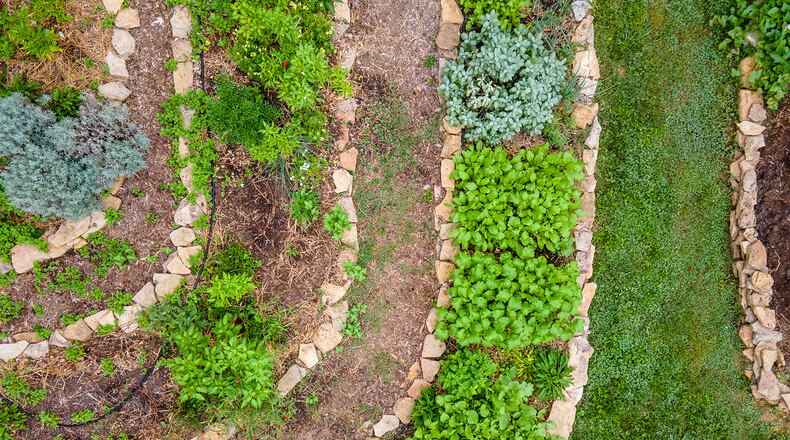Nothing beats spring in Atlanta as the first daffodils and hyacinths bloom and Atlantans high tail it to the garden store and crank up their lawnmowers. The anticipation and sense of excitement is palpable: Gardens represent our deepest desire for renewal and a fresh start that can feel more powerful than even the new beginnings promise of New Year’s Eve.
If planting fruit, vegetables, herbs and ornamental plants is part of your spring garden plan, now is a good time to start thinking about not just what you will be planting but how. Because as HGTV editorial director and garden writer Kelly Smith Trimble notes in her 2023 book “The Creative Vegetable Gardener: 60 Ways to Cultivate Joy, Playfulness, and Beauty Along with a Bounty of Food,” vegetable gardens are occasions to not just create something practical but also an opportunity to serve up beauty.
Trimble especially likes mixing vegetables with flowers including her current favorite “passionflower vine, a perennial that’s native to many states in the Southeast.” Trimble finds many of her plant seeds and garden materials at purveyors such as Southern Exposure Seed Exchange, Sow True Seed, Truelove Seeds, Grand Prismatic Seed and TerraTrellis.
As design infiltrates so many facets of American life, vegetable gardening is another opportunity to bring aesthetics to bear. Trimble offers a wealth of tips for creating a garden as delicious as it is nice to contemplate.
Credit: Hilary Dahl
Credit: Hilary Dahl
Look to nature for inspiration. “Rarely does Mother Nature plant in straight rows of single species,” said Trimble. “Instead, biodiversity is key for success in nature. Embrace mixed plantings and a more natural look. Mixed planting is akin to companion planting because you’re mixing plants together for mutual benefit, and the benefits vary. You can mix plants to attract pollinators, to confuse pest insects, to grow more in a small space, or because the colors complement — just be sure to give plants plenty of water and nutrients (mostly through compost) as plants grown closely together will compete for resources.”
Seek out other garden styles for inspiration. “Rather than looking at traditional kitchen gardens, vegetable gardens or farms, I’m inspired by cottage gardens with their mix of colors and harvests ranging from food to herbal medicine to flowers; perennial gardens and native gardens that change through the seasons; and labyrinth and meditation gardens with their focus on the spiritual and emotional solace a garden can provide.”
Credit: Derek Trimble
Credit: Derek Trimble
Play with shape and texture. “Often, vegetable gardens rely on angular, rectangular shapes for a sense of order. But garden beds don’t have to be rectangles,” said Trimble. “Spirals, snake and wave shapes, triangles, and hexagons are some other shapes to consider. Hexagons appear often in nature, including in honeycombs. Fitting a few hexagon beds together can create an arc shape that I love. Gardener’s Supply Company sells cedar hexagon bed kits, and I hope other retailers will catch on to this twist on the traditional square or rectangular cedar bed.”
Try a trellis. “Trellises also add a sense of design through height and shape, in addition to serving valuable functions like getting plants off the ground [to help prevent disease] and maximizing a small space. I grow cucumbers, tomatoes, beans and peas on trellises,” said Trimble who has been eyeing the Gracie Arbor Trellis from TerraTrellis.
Credit: Derek Trimble
Credit: Derek Trimble
Mix materials. Trimble suggests adding texture by using wood, metal or stone to make garden beds and by playing with the materials you use to make trellises and stakes.
Let plants bolt. “I also let some vegetable and herbs like parsley, fennel, parsnips, chives, arugula, lettuce, and collards bolt [flower and go to seed] in my garden,” said Trimble, “because the flowers attract pollinators. These flowers can also be a fun and surprising addition to arrangements.”
Credit: Derek Trimble
Credit: Derek Trimble
Use dark-colored plants. Trimble likes to incorporate “lots of dark purples especially. In the edible garden, there are many darker varieties to choose from, from Dark Opal basil to Sugar Magnolia snap pea to Autumn Beauty sunflower and Cherokee Purple tomato, which is also a regional heirloom.”
Grow flowers with your vegetables. “I will never again grow a vegetable garden without growing flowers in it, too. Some of my favorites are zinnias, calendula, gem marigolds, yarrow, echinacea, cosmos, and nigella,” said Trimble. “I also adore sunflowers and love growing smaller varieties like ‘Short Stuff’ in my vegetable garden.”
Felicia Feaster is a longtime lifestyle and design editor who spent 11 years covering gardening, interior design, trends and wellness for HGTV.com. Felicia is a contributor to MarthaStewart.com and has been interviewed as a design expert by The New York Times, Forbes and the Associated Press.
About the Author
Keep Reading
The Latest
Featured





